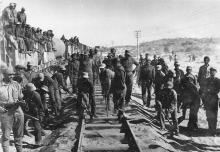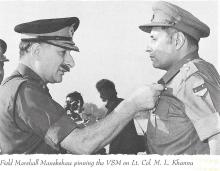December 3, 1971! On a wintry Friday evening, in a series of pre-emptive raids, the Pakistani air force struck various air force bases in North India, triggering the 3rd war between the two sub-continental giants. This was one of the shortest wars in history and lead to the formation of a new nation – Bangladesh. While India’s quick response and its overwhelming victory are too well known to need repetition at this stage, what is not highlighted in the war’s chronicles is the role of the Railways in the conflict. Lt. Col. M L Khanna, then Commanding Officer of 1033 Railway Engineers (TA), writes of the experience of his unit during the early days of the war. Lt. Col. M L Khanna was then a Deputy Head of Department on the Western Railway and later retired from Railway service as a Member of the Indian Railways Board.
His story...
The dilapidated road sign read: Welcome to the land of 5 S’s – Sand, Sandstorms, Sand-dunes, Snakes and Scorpions. We were crossing the international border between Munabao in India en route to Khokhrapar in Pakistan and beyond towards Hyderabad in in Pakistan’s Sindh province. It was December, 1971, and the Indo-Pak war had just begun. We – a Territorial Army (TA) battalion of about 1000 railwaymen-turned-army men – were called upon to activate and then operate the 40 kms. rail line of the Pakistan Railways in the middle of the Thar desert that straddles the two countries at this point. Our task acquired great urgency as our advancing troops were left with meagre rations of food, water and ammunition. Our army’s quick advance was creating a logistics nightmare as supply lines became longer and stocks dwindled by the hour. With no road in the desert for plying of army trucks, the problem was becoming critical and the running of supply trains imperative. Our unit, the 1033 Railway Engineers (TA), comprised of railwaymen from the Western Railway Zone of the Indian Railways and had been called upon when war was declared to don army uniforms and assist the war effort by giving support to the fighting troops.
Our first task was to bridge the gap between the two lines on the Indian and Pakistani sides. This was accomplished in a day and the first train carrying water in rail tankers and some other supplies steamed into Khokhrapar the following day. Since we were always in danger of air attacks, the non-TA railwaymen who had helped run this train were evacuated and leading contingents of the TA took over. However, this was only the beginning of our task: the supplies had now to be carried 30 kms. to the front line where the battle raged.
The last contingent of our unit was still on its way in a special military train which was approaching Barmer and was scheduled to arrive there at 8 p.m. Apparently, Pakistani intelligence had got a whiff of this and its planes bombed and strafed Barmer railway station area that while night, with the aim of destroying the unit that was to activate the Pakistan Railway in the area that our army had over-run. After spending a couple of hours in a trench in the bitter cold, since the bombing ceased to abate, we went around to see if our men were safe. Fortunately, they were. Along with Major O P Nayar, my Second-in-Command, I spent the rest of the night in the Station Master’s office assessing the damage and planning for the future.
Quite obviously, the target of the sustained bombing by Pakistan’s bombers was the military special that was carrying the last part of our unit according to its scheduled arrival. What the Pakistanis did not know was that by a subsequent order (half by anticipation and half by sixth sense) the train had been halted 20 kms. away. Safe and in one piece, the train resumed to its destination soon after the air raids receded.
It was the next morning that we arrived at the above mentioned signboard. It was dark when we reached Khokhrapar Railway station in Pakistan. The last act of the day was a late night conference in total darkness when plans for the next day and allocation of duties were decided – to survey and repair the next 30 kms. of track right up to the front line where our infantry had dug in and were surviving on minimal supplies. To add to our woes, the enemy had damaged and destroyed many of the culverts and parts of the track as they retreated.
The next day saw the unit working at a feverish pace. We worked the whole day, restoring the line to a minimum level of fitness. As the sun sank over the distant dunes and darkness draped the desert, we returned to Khokhrapar, now our advance base. As we were fortifying ourselves for dinner, Pakistani planes struck again. They withdrew after setting an ammunition dump on fire. Guessing that they would not return till dawn, we quickly assembled the first supply train of about 20 wagons loaded with food, water and, above all, ammunition.
It was past midnight when the train moved slowly and stealthily into the darkness. In time, we stopped near a station deep inside Pakistani territory just behind the front line. After a few moments of jubilation, unloading began and was almost completed when dawn broke with the arrival of more Pakistani planes. In the bombing that followed, the locomotive driver, Durga Shanker, suffered burn injuries from a napalm bomb. To avoid further losses, the train was ordered back to Khokhrapar, the brave driver offering to work the train with his elbows as his hands were burnt. The train in reverse motion had covered about 12 kms. when 4 rail tankers derailed between two high sand dunes, where visibility was nil. Pushing of a long train is hazardous in the best of times and is normally not resorted to in peace time movement.
Our next task was clearing the obstruction caused by the derailed tankers. Working during the day in the open was an invitation for air attacks. We were fortunate that we were aboe to work till 4 p.m. without any disturbance from the air. This is when our luck ran out as 4 Pakistani Starfighters returning from a bombing mission over India spotted us. Luckily, they had exhausted their bombs on the mission. However, one of the planes circled back and dived to strafe us. As he dived, I could see the Pakistani pilot adjust his guns, before he opened fire and sprayed the desert around us with thousands of bullets. The desert has no place to take cover, so the 100 of us lay motionless waiting for the worst. The bullets missed us by a few inches. What saved us was an anti-aircraft gun we had mounted on the train as a last minute innovation. We knew that the planes would come back fully loaded and charged. So, we finished the work quickly and returned to Khokhrapar. On arrival, we found Khokhrapar ablaze. Luckily, all our men were safe and the morale of these part-time army men was high.
We continued running these supply trains not only till the end of the war on December 16 but for a few months beyond while India held the Pakistani territory between our border and Naya Chor. The Army recognised the contribution of the railwaymen and our unit was decorated with one Vir Chakra, two Vishisth Sewa Medals and 3 Mention in Despatches. The Vir Chakra was won by the driver, Durga Shanker. To this day, this is the only Vir Chakra won by a member of the Railway Territorial Army.





